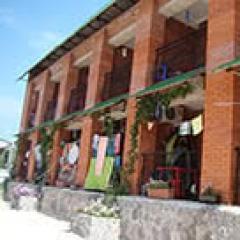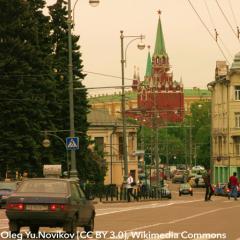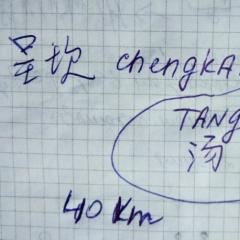Review of interesting cities in Germany. The largest cities in Germany Cities in East Germany
To better imagine a country you have never been to, you need to learn about its cities. For example, the largest cities in Germany can tell not only about the population, but also about the cultural heritage and customs of the country.
Largest cities
Hamburg, Munich and Cologne boast a population of more than a million inhabitants, and the capital has more than 3.5 million residents. Frankfurt am Main falls just short of the million mark, followed by Stuttgart and Düsseldorf.
If we talk about attractions, we should start with the capital. The Brandenburg Gate is the hallmark of Berlin.

Tourists on excursions also like to visit the Reichstag, the Philharmonic, the National Gallery, the Cathedral and the Red Town Hall. The whole family can have a great time at the largest zoo and amusement parks. A walk along the green, clean streets in the evening is especially pleasant.
Berlin is not just an architectural and cultural center full of museums and art galleries, it also hosts famous festivals.
For example, the Berlin Film Festival attracts a large number of tourists and film lovers. The Jazz Festival is another world-famous event taking place in the German capital.
– the largest port in Europe and the world. In this regard, the city's industrial production is mainly associated with port activities. Although the city is large, it does not look gloomy. On the contrary, it is full of green spaces.

The feeling of spaciousness and convenience is created by passages, covered streets and other buildings, which, as a rule, are no higher than 10 floors. The picture is completed by the presence of more than 2,000 bridges and countless canals.
No wonder Hamburg is compared to Venice. Nightlife lovers will be interested in the red light district.
- the capital of Bavaria, is located at the foot of the Alpine mountains and is beautiful in every way. It is an industrial, commercial, financial, scientific and cultural center. The automotive industry, electrical engineering and tourism are the main sectors of the economy.

More than 45 museums, several symphony orchestras, numerous theaters, publishing houses, cinema and television companies - this is not a complete list of the city’s advantages. Architecture lovers will see buildings of different styles and eras, and connoisseurs of delicious food will enjoy sausages and pretzels.
The beer festival, held every autumn, offers delicious beer and hospitality. An important feature of the city is that it is easy to find work here even for foreigners, despite the large number of residents.
- a city of parks. If you look at it from a bird's eye view, you will see a beautiful green city, consisting of two parts, separated by a river. At the same time, transport links do not suffer, since both banks are connected by 8 bridges.

A large number of ancient churches and the famous cathedral attract pilgrims, and for beer lovers there are many beer gardens. The big event is the spring carnival, which takes place over 4 days.
Having considered the features of only a few large cities in Germany, one can understand that this is an amazing country, rich in traditions and cultural heritage. People with diverse tastes and preferences will be able to spend time here pleasantly and profitably.
The largest cities in Germany
There is an amazing country in the Central part of Europe; visiting it will be interesting not only for a novice tourist, but also for a traveler seasoned in long journeys.
We are talking about Germany, this unique state with its legends. When a conversation begins about cultural, architectural and historical monuments, majestic buildings, monuments and statues immediately come to mind, but the country’s large cities are also unique landmarks of the state.
In Germany, the largest settlements are rightfully considered the capital of the state Berlin, and Hamburg, Munich, Leipzig, Bonn, Dresden, Dusseldorf and some other cities no less famous to the world.
In this unspoken list, Berlin confidently takes first place, both in terms of area and number of residents. No one knows the exact date of its origin; it is only known that on the site of the modern city at the beginning of the 13th century there were two neighboring settlements - Cologne and Berlin, which a century later were united to form a single city government.
Modern Berlin is home to more than 3.5 million people on an area of more than 5,300 sq. km. The Brandenburg Gate is a unique calling card of this ancient city. Next to the majestic structure there is a section of the intact “Berlin Wall”, which at one time divided the country into two parts. The list of attractions of the capital can be listed endlessly - St. Hedwig's Cathedral, Unter den Linden street, Berlin Zoo, Charlottenberg Castle and many other historical and cultural monuments.
The second largest city in Germany is the largest European seaport of Hamburg, home to about 2 million people. This settlement is famous for its huge number of bridges; there are more than two thousand of them, which is several times more than in St. Petersburg, Amsterdam and Venice combined. Hamburg is known throughout Europe for its covered streets and arcades, which originate from the Hamburger Court - the city's shopping center. But that’s not all - it is in this city that the Reeperbahn is located, the red light district, where, like moths to the light, many lovers of vibrant nightlife flock.
Next on the list is Munich, where the population is about 1 million 350 thousand people. A modern city is both a “big village”, and a metropolis, and a city of cinema, and the industrial capital of Germany, and a huge open-air museum, where all architectural styles, from Art Nouveau to Gothic, coexist peacefully. It is also impossible not to mention the world-famous Oktoberfest beer festival and the equally famous Bavarian cuisine.
You can talk about Germany endlessly, but the best way is to see with your own eyes the splendor of this ancient country.
The list of cities in Germany, like, in principle, the list of settlements in any other developed country, is quite voluminous. There are many small ones, but also many large ones. This topic is detailed and interesting, so it’s worth focusing on it.
Briefly about the topic
First of all, I would like to note that modern Germany is divided into 16 separate federal states. Many people mistakenly believe that each of them is a separate state. But no, it’s just a federal land - just like here in Russia.
Does not include Berlin, Bremen and Hamburg. These are separate cities. The similarities with Russia are also noticeable: after all, Moscow, St. Petersburg and Sevastopol are separated by the same status. Although the above German cities are equal in importance to the lands.
A little history
Before listing the list of cities in Germany, it is worth delving a little into history. Until the middle of the year before last, the 19th century, small individual states existed and flourished on the territory of this country. They often changed their own boundaries. Initially there were 11 of them, but then, when three states (Baden, Württemberg-Baden and Württemberg-Hohenzollern) united, there were nine. At the same time there were districts, of which there were 14. But in 1990 changes occurred. The eastern and western parts of the German capital united, and in the eastern part of the country they decided to restore everything as it was. So there are 16 lands.

Free lands and cities
Before announcing the list of cities in Germany, I would like to talk about the lands. So, the first one is Baden-Württemberg. It was formed in 1952, when three lands united (this was discussed above). Considered one of the most prosperous and developed, the capital is Stuttgart.
Bavaria is the largest state in Germany. Its capital is the famous Munich, the birthplace of BMW and Bavarian traditions. Berlin is the main city of the entire country; until 1920 it was part of the state of Brandenburg. And by the way, it is located in the northeast of the state. The capital is Potsdam, a small but cozy town.
Bremen, a free Hanseatic city, is the smallest state in the country. It consists of only two cities. These are, in fact, Bremen and Bremerhaven. Just like Bavaria, it is the most ancient entity in the country. Hamburg, by the way, is also a free Hanseatic city. Moreover, it is the largest port metropolis in Europe! Located where the Elbe flows into the North Sea.

Other lands
Quite famous cities in Germany were listed above. The alphabetical list in Russian is provided in full below. And now - in more detail about the remaining lands.
Hesse is located in the very center of Germany. This is a land with the capital of Wiesbaden, the name of which comes from an ancient Germanic tribe. Vorpommern (or, as it is also called, Mecklenburg) is located on the coast of the Baltic Sea. The capital is Schwerin - a city with picturesque castles and amazing nature, located among lakes.
Located next to Bavaria. The capital is Hanover, a port city with a population of half a million. North Rhine-Westphalia is a land whose main city is the famous Düsseldorf. In the southwest is Rhineland-Palatinate. Its capital is Mainz, a major German media center.
Saarland (or simply Saarland) is one of the smallest lands in the country. Borders with France. Dresden is the capital of the Free State of Saxony, and Magdeburg is the main city of Saxony-Anhalt. Schleswig-Holstein is located in the north of the country. The capital is Kiel, whose sister cities are Kaliningrad and Sovetsk.
And finally, a free state called Thuringia. This is the so-called green heart of Germany. Located in the very center of the country. Its capital is Erfurt, a university center. All these, to their advantage, are large cities in Germany. The list is quite long. Therefore, it is not worth listing them all.

Small settlements
In principle, people more or less know the list of cities in Germany. But when this topic is mentioned, only the names of large capitals come to mind. But there are also many such settlements as small towns in Germany, the list of which is also voluminous.
For example, Rothenburg od der Tauber. Cozy, small, with a population of 11 thousand people, with bright houses and narrow streets. Minden is also a small town. Few people know that the second longest water bridge in Europe is located here. Villingen-Schwenningen, Velbert, Flensburg (by the way, the northernmost settlement in the country), Tübingen, Marl, Dessau (Junkers aircraft were once produced there), Lünen, Ratingen (green and picturesque), Ludwigsburg with the famous Baroque palace , Esslingen am Neckar (founded in the eighth century), Hanau, Düren…
This is a list of cities in Germany that are the smallest but notable. Their population is less than 100 thousand people. By the way, such towns are very popular among tourists.

Studying the list, one cannot help but note what made these settlements famous. For example, Recklinghausen is famous for the fact that it houses an icon museum - the largest museum focused on religious values.
In Bergisch Gladbach, for example, iron ore was mined for a long time. In the last century there was simply a huge supply of it. Göttingen is well known to Russians, since this is where a large number of our compatriots live. Pforzheim is the city that suffered the most from wartime bombing. Heilbronn is famous for its winemaking and salt mines. By the way, in the places where this city was founded, traces of humans were first noticed during the Paleolithic! Fürth is a city known as the densest city in terms of the number of monuments. Knoys is known for a rather unusual fact - the fact that a local witch named Esther Jonas was executed here in the 17th century. Although she was just doing medicinal herbs.
Here, in principle, are the most interesting cities in Germany (the alphabetical list in Russian is provided above). As one might understand, small settlements, whose names are not well known to everyone, can boast of something.


